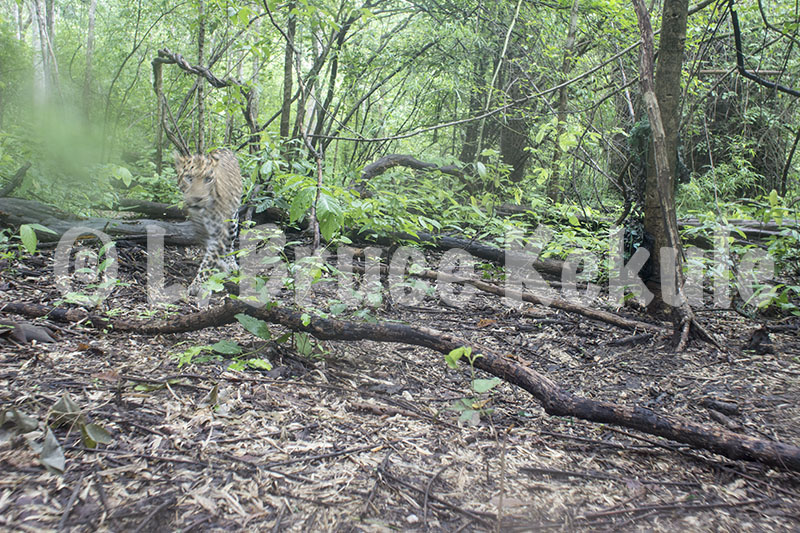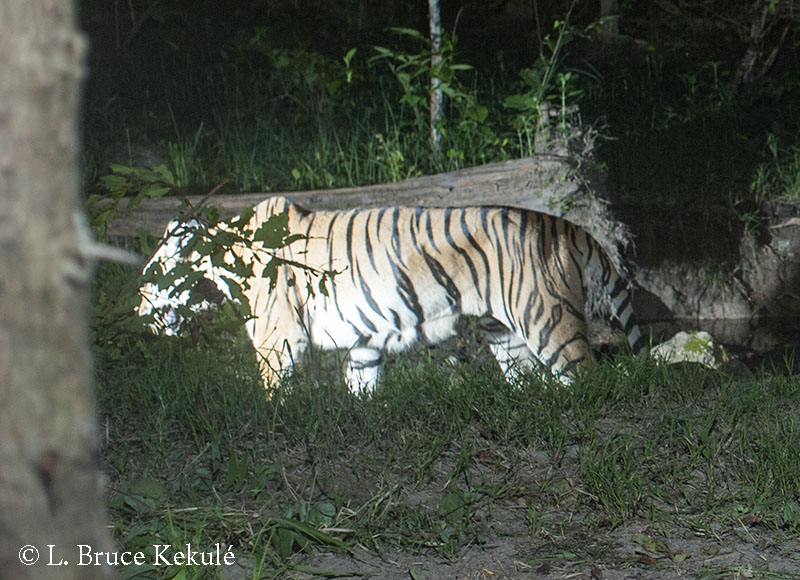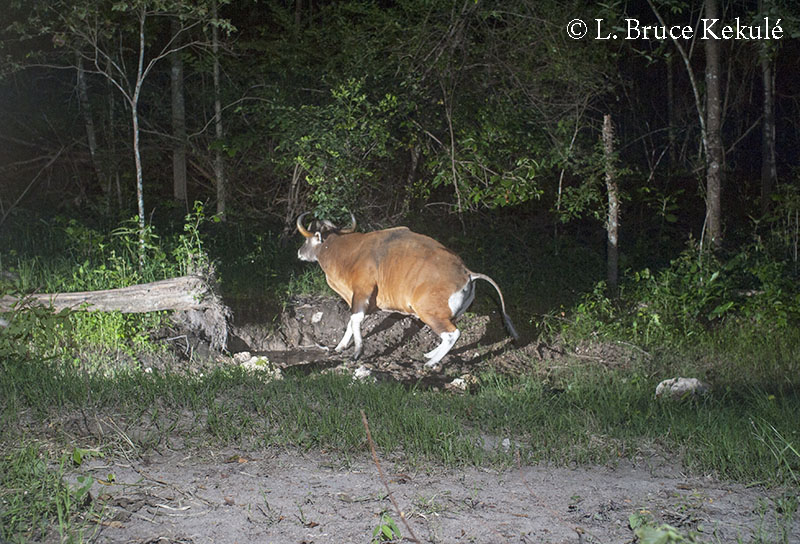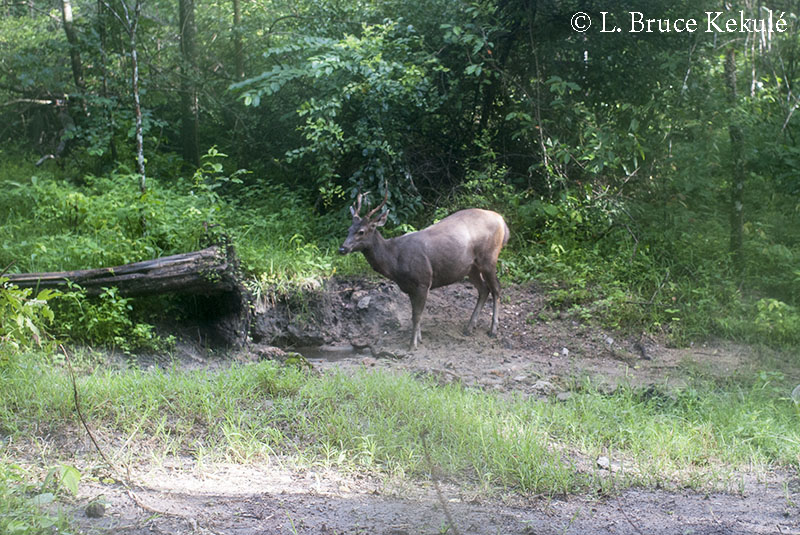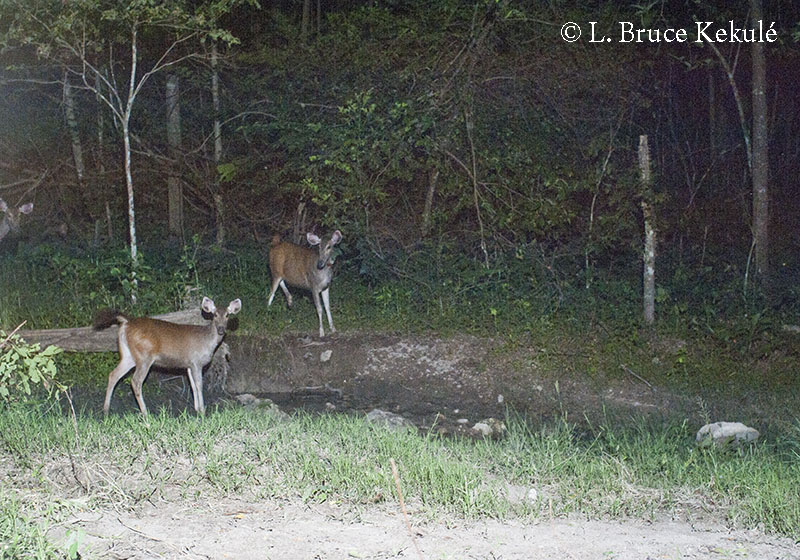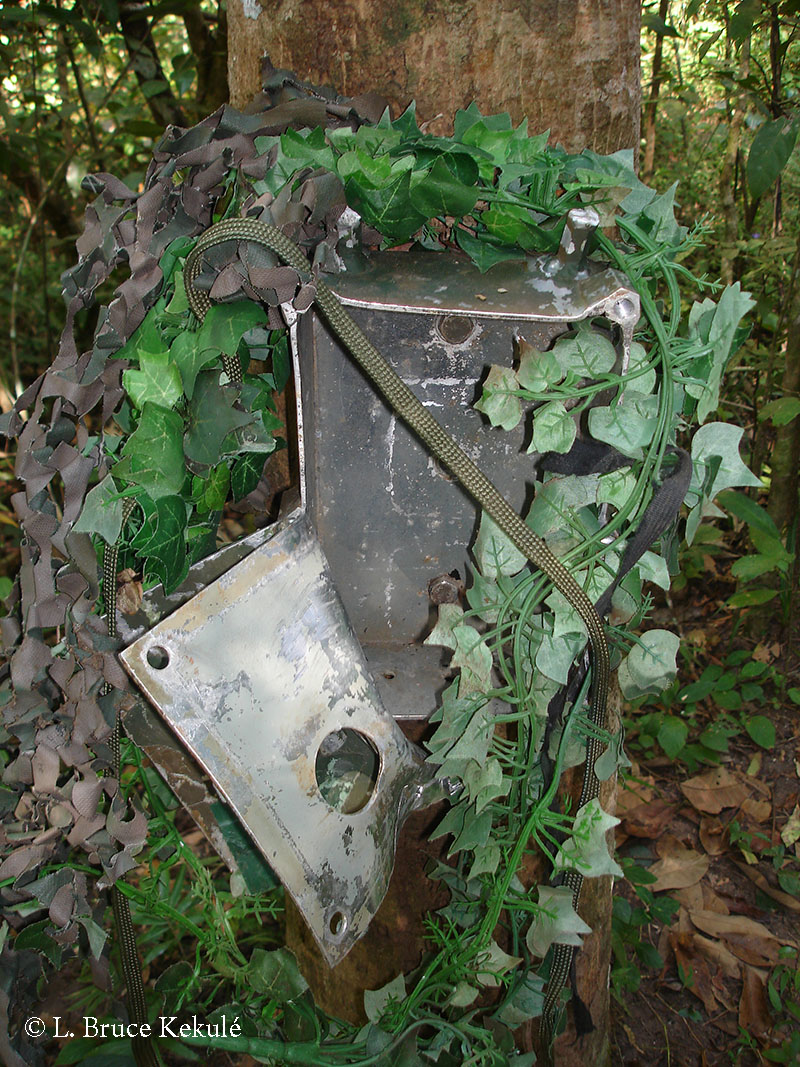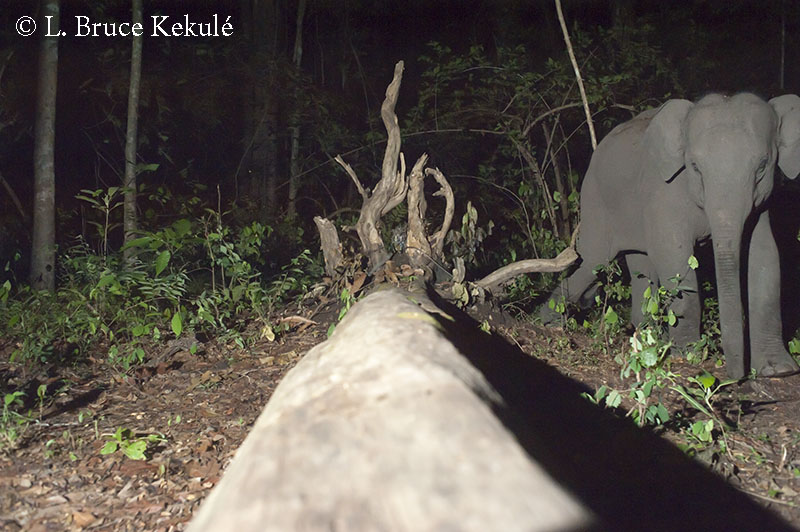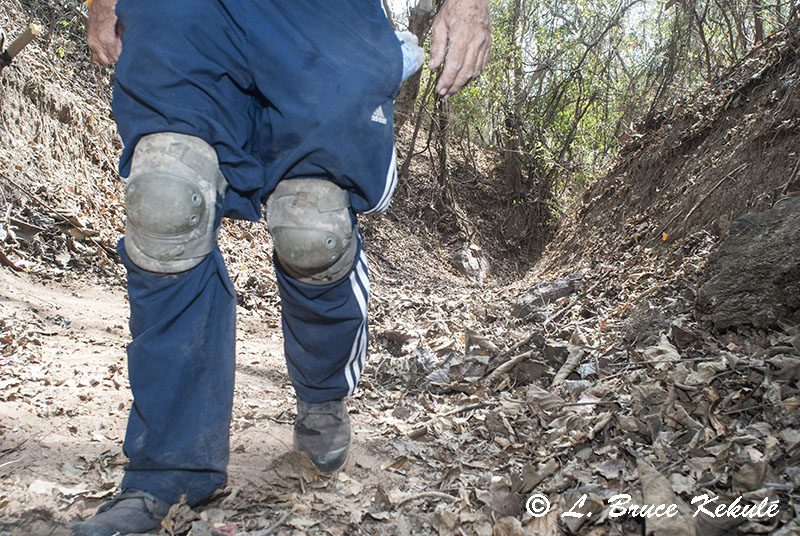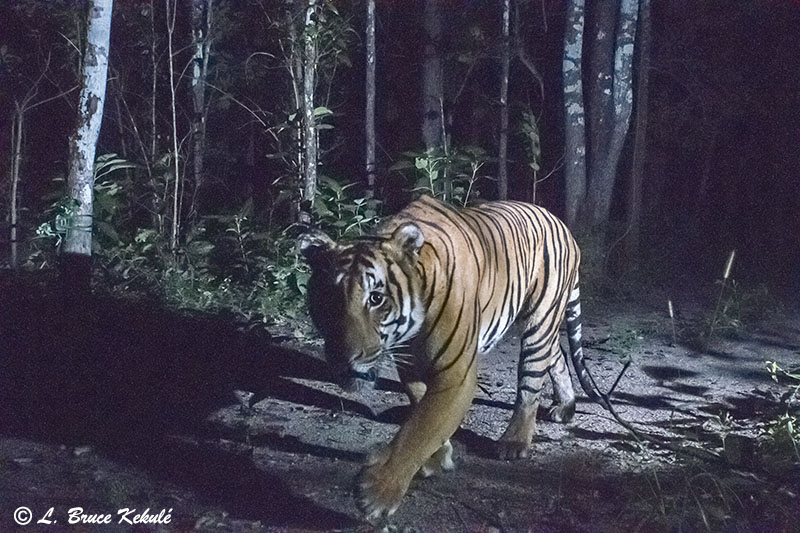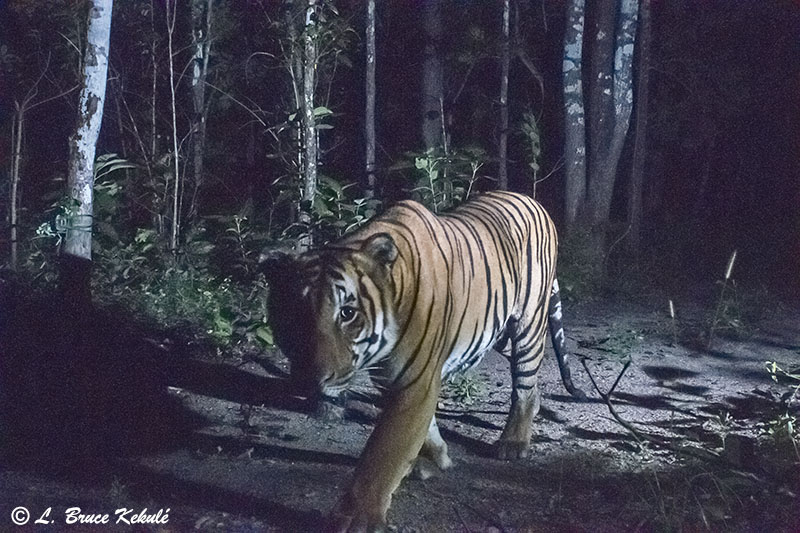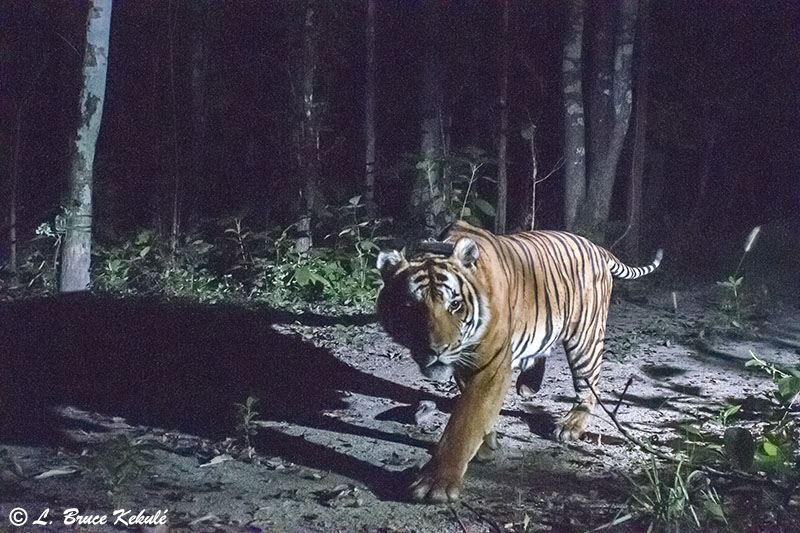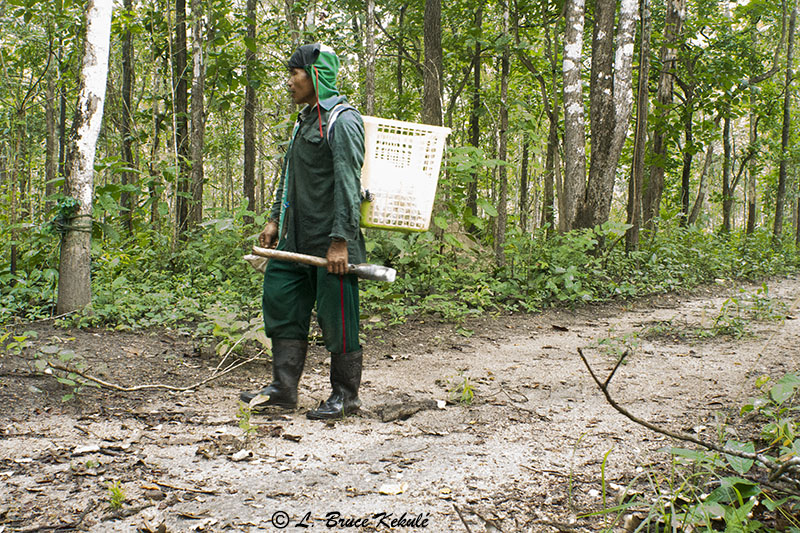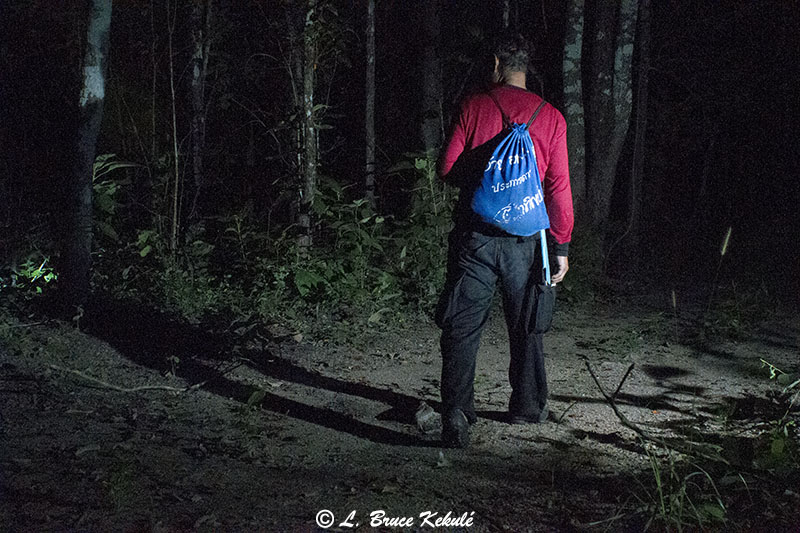Posts Tagged ‘DSLR camera trap’
Botched shutter speed and focus…!
Two Asian leopards pass-by my Canon 600D
For the most part, I usually catch something interesting on my camera traps in the ‘Western Forest Complex’ of Thailand. This place is one of the last great Asian forests where rare wild cats like leopard and tiger still thrive plus many other cryptic animals like sambar, banteng, gaur and tapir living alongside the predators. It does not matter if the camera was set right or wrong. I still manage to get some good record shots of black and yellow phase leopards at this new location.
A black leopard on my birthday: May 19th at 1.49pm, exposure: 2.5 sec…a lucky catch…!
A yellow phased or spotted leopard on May 28th at 8.13am, exposure: 1/8 sec.
A spotted leopard on June 19th at 2.41pm, exposure: 0.3 sec.
A spotted leopard flashing by on May 28th, exposure: 0.6 sec.
I’m not sure how my 600D jumped from ‘Manual’ over to the ‘Tv’ setting (shutter speed priority) but the answer is obvious. I somehow moved the wheel and did not double check it before closing up the cam. So all the shots had very long exposures hence blurry and out-of-focus images. However, the proof that leopards do thrive at this location is still good news. And the bad news is:
Stolen Nikon D90 DSLR camera trap…!

My first DSLR camera trap; a Nikon D90 and SB400 flash with a Yeti’ board in a clear Plano box…!
After capturing leopards on my Canon 600D, I hated to pull it out but had no choice. When I set the Canon, I also set a Nikon D90 DSLR (shown above) in an ‘elephant proof’ box a little bit further down another well-used trail (about 100 meters away). After I checked the Canon, I went straight to the Nikon but it was gone. Someone had stolen it plus two Nikon SB-28 flashes and a SSII (Snapshotsniper) sensor. The complete rig had been taken including the ‘aluminum housings’ and all the hard-wiring. This is my third camera stolen in this ‘World Heritage Site’…!
I have no idea who it is but one thing for sure; it’s the same group that stole my Bushnell Trophy Cam video and ‘Fireman Jim’ 125 DXG video in another section of the sanctuary earlier this year. It means that someone has the special ‘power-torque’ wrench to open-up the ‘elephant proof’ housings, and a 17mm socket wrench (for the 3/8 X 3″ stainless lag bolts) to remove the aluminum boxes from the trees. The ‘power-torque’ wrench is only available at a few special tool shops in Bangkok, or it was found in the forest where I lost one awhile back. Needless to say, it’s back to the drawing board to beef up security of all my cams. I have a new design that will make it even harder to steal that I will post at a later date…!
A camera trap set at Ken River Lodge – Panna Tiger Reserve – India
Nikon D3000 travel cam catches a palm civet, jackals, wild boar, langur monkey and a semi-feral cat…!
An Asian palm civet in a dry stream bed at the Ken River Lodge, Panna Tiger Reserve, Madhya Pradesh, India…!
In March 2016, I made a trip to Panna Tiger Reserve in India after tigers. I was lucky catching two sisters, the offspring of T1, Panna’s first tiger reintroduced from near-by Bandhavgarh Tiger Reserve. Poachers completely wiped out the big cat in Panna in one year during 2008 but there are 32 tigers thriving now which is an amazing conservation success story.
Jackal shown here bolting from the flash…! These canidae usually travel in pairs…!
I stayed at the Ken River Lodge outside the reserve several kilometers from the front gate to the park. Pugpundee Safari Company manages this hotel plus others in Bandhavgarh, Pench, Kanha and Satpura tiger reserves in the State of Madhya Pradesh.
A wild boar scavenging in the stream bed…!
The owner wanted to see what was roaming the grounds and invited me to set a camera trap in a dry stream bed not far from my room. After two weeks, I came back through to check the Nikon D3000 with a Nikon 24mm manual lens, one Nikon SB-28 flash and a SSII external sensor.
A gray or ‘Hanuman’ langur leaf monkey during the day….!
The cam caught a palm civet, a pair of jackals, a wild boar and a langur monkey plus a semi-feral cat. Although not as glamorous as a tiger or leopard, these wild creatures are still just as important to the ecosystem excluding the cat. Leopard tracks have been found near the river..!
A semi-feral cat; sometimes this feline was found sleeping up at the resort…!
The ‘tiger hunter’ with knee pads walk-testing the D3000…!
An ISO Blunder
Sony A500 catches a tiger and poachers at ISO 12,800
Sometimes, mind lapse is a serious problem for a senior citizen like myself. I set my Sony A500 on a trail just inside the boundary of my favorite protected area in Thailand. This location has already produced some amazing shots of black leopard and tiger plus many prey species like elephant, banteng, barking deer, sambar and wild pig.
Tiger passes the Sony A500…!
Tiger with a radio collar passes the Sony…!
On the negative side of things, this cam has also caught poachers and gatherers as they illegally sneak into, and exit the sanctuary. Poor patrolling and enforcement with many loopholes allow these undesirables to penetrate and poach animals and forest products for sale or personal use. It is a serious threat to all of Thailand’s protected areas and is on-going problem for the Department of National Parks (DNP)…!
Poachers with baskets and digging tools after bamboo shoots during the rainy season…!
Wildlife poachers with no basket…!
This Sony has been working very well catching a male tiger with a radio collar at night several months ago. I noticed that several people on the forum were setting their cams at ISO 200 and thought I would give it a try. When I left the cam, I thought it was at the 200 setting.
A month or so later, I went back to change out batteries, card and desiccant, and saw the same tiger with a collar had visited twice plus some poachers caught using the same path. When I downloaded the images, I was shocked to see the ISO at 12,800…what the heck happened here…?
I don’t know but it looks like I did not save the settings before buttoning up the cam and somehow pushed the 12,800-button. This was of course another disappointment. The shots are cluttered with noise and I have tweaked the images but it’s a fact: photos with ISO this high is absolute rubbish and can only be counted as record shots.
Another thing: only one flash on the right was working hence the deep shadow. I found a broken wire on the other flash so brought the whole unit in for repair. I will be setting another Sony (A55 with a 55mm lens) DSLR cam with 4 flashes (hard-wired) to see what might pass-by.
The ‘Tiger Hunter’ setting a Bushnell Trophy Cam…!
The A500 cam is now back in the forest but at a new location with settings at ƒ8 – 1/125 – ISO 200. It was working well firing off 4-shot strings during walk test and hopefully it will produce some good shots now. Leopards and tiger plus all the other denizens of the Thai forest use this trail so I can only wait till I get back to the cam in a couple weeks.……!
Indochinese tiger male caught on video and DSLR
A video and still photos of an Indochinese tiger in the Western Forest Complex of Thailand. This male cat was camera trapped in the afternoon and then in mid-morning…a beautiful carnivore.
The message is the same: these magnificent cats need 100% increase in protection and enforcement as they have become extremely rare in the wild. Unfortunately, some bad people chase after them for bones to be sold on the black market…! The main worry is that help will come too little and too late to really save the tiger and other creatures of the Thai forest…! Enjoy the beauty of raw nature but never forget this message: We need to work hard to change things so these magnificent cats will continue to roam the forest…!
Nikon D700 catches an Indochinese female tiger sporting a radio collar…!
Tiger research in the Western Forest Complex (WFC) of Thailand
Indochinese tiger female sporting a ‘radio collar’ at the tiger log…!
First off, I want everyone to know that I’m not against research that is extremely important for knowledge of the natural world. The practice of studying animals and behavior is needed to understand how Mother Nature’s beings and biospheres live in a complex world. Some people might take offence to the relevant facts stated below but things need to change quickly in order to really save the tiger, and other creatures and ecosystems of Thailand’s natural heritage.
Close-up: A serial numbered tiger and the number can be seen written on the collar.
Frankly, there are some projects that are on-going and not up to standard that have caused many tiger deaths, directly and indirectly. Such is the ‘tiger research’ carried out that is mediocre to very poor to say the least. The researchers working on tigers here have a track record that simply is not acceptable…!
Many problems have come to the forefront about the system of capturing the big cats with snares and then shooting them with darts to sedate them. Some tigers have escaped the snare and ended up with a limp because of pulled joints, tendons and ligaments. This is a serious problem as the cat now cannot chase down its normal prey like deer and pigs, and quickly dies of malnutrition. Botched tiger captures using wrongly administered drugs to sedate tigers has also been noted. The tigers could not be revived and the animals were simply buried and the news suppressed.
Serial numbered tiger – #164 900 – 2014
Another problem of making broad statements about the amount of tigers in certain areas and broadcasting this plus other pertinent ‘radio collaring’ information on national TV channel is like sounding the death knoll to come and get these magnificent creatures. There are still many bad elements in our society and these cold-blooded killers think nothing about dispatching a tiger for its bones used in the making of Chinese medicine and wine. It’s all about money and human greed…!
This has also happened in India where researchers published their work in the local newspapers, and on the radio and TV how many tigers were in Panna Tiger Reserve and within one year, the cats completely disappeared as poachers moved in and systematically killed them all in one quick swoop. Tigers like all big cats, come to carrion and if a carcass is tainted with poison, it’s just a matter of time before the whole local wild feline population is wiped out. They disappeared under the forestry staff and researcher’s noses. Because it is in open forest, other animals like bears, civets, all the cats, wild pigs. vultures also perish. How could this happen..?
Other stories on the Internet can be found about tigers with collars not breeding very well was also documented in India. Finally, researcher’s laptops have been hacked into and important GPS data on tiger whereabouts was stolen. These high tech poachers can kill a population in a jiffy.
Putting collars on young tigers is a serious no-no but this has been done here in the name of research with the researchers finding the collar had stopped moving and the cub found dead having quickly out-grown the leather strap suffocating it. Another serious occurrence of taking tiger cubs out of their den for research data gathering purposes, and then coming back a second time to photograph the researchers holding the cubs. The mother tiger abandon the den and the cubs ended up dead. This is a serious breach of protocol and the National Parks law…!
Needless to say, these people continue to carry on like nothing has happened but these are facts backed-up by reliable sources and boots on the ground. And what is really worrisome is the fact that several international NGOs and a U.S. university are backing this program.
Other tribulations like bringing domestic cattle to act as ‘tiger bait’ was ongoing until recently, and who knows if any disease like ‘foot and mouth’ or ‘anthrax’ was introduced into the sanctuary during this time. The cattle were purchased locally (sometimes, diseased cows are illegally imported from nearby Burma). This baiting technique was used for several years and the researchers brought these domesticated cattle in by the truckload. A cow was then tied to a stake and a bamboo enclosure built around it with only one opening and they built scores of them in the forest. Of course hay and water were provided to the cow. A tiger would step in and maybe get snared. This practice fortunately has been suspended. This is just another breach of the law where domesticated animals are not allowed in wildlife sanctuaries that have been set aside for biodiversity and research.
The researchers already have loads of data including identifying individuals and home-range information through camera trapping, plus the data from the 8-10 collared tigers. My feeling is that the collaring process should cease as there are far to few tigers left in the wild. No amount of research can justify even one tiger getting killed in the name of science. There are only about 3,200 left in the world, and maybe less than 250 in Thailand. It is time to seriously concentrate on protection and enforcement only and less emphasis put on research. We already know there are tigers in WFC, one of the greatest tiger reserves in the world.
Most unfortunate are the old laws that apply to wildlife and protected areas that seem to perpetuate lawless people from being put away in jail. Most poachers and forest product gatherers get light fines and a slap on the wrist when apprehended in national park land, even with solid evidence. The park officials must bring all poachers to the local police station, which then starts another wheel of corruption at a higher level. If the case gets into the courts, pay-offs are used to get light sentences and sometime off ‘Scott-free’. There are very few convictions and long-term jail sentences although once in awhile, some do end-up in jail as a consequence but the ratio of convicted poachers to released offenders is small.
The biggest problem is simply there are not enough ranger personnel to look after these remaining tiger reserves and, budgets are slim and sometime non-existent. My biggest concern is that everything will come too late to save the tiger from extinction. Lawmakers and budget people need to get their head out of the sand but that will take an act of god (AOG) to get going in a culture that thrives on corruption.
One of the most important things to get established in Thailand is a dedicated ‘ranger school’ so that the ranks can be filled with well trained and equipped personnel. The present ranger numbers need to be increased by over 100%. Several revolving 5-man teams need to patrol with men always in the forest from their respective ranger stations. This is the only way to keep the poachers at bay. Again, this will basically need an AOG to get done.
Once again, I’m not against research, but a line must be drawn in the sand. Too much money and effort goes towards this activity and very little into protecting the wildlife and biospheres here that the researchers are researching. This is just not right and I for one, want to try and change things here so that wildlife at least gets a fair shake.
At the end of the day, the only thing that will help Thailand’s tigers in the long run is also a serious look into the middlemen and end-users of tiger bones and other forest products. These people must be apprehended and the masses educated to see the fallacy in using wild animal parts to cure ailments. The Asian medicine trade is still in full swing and will be next to impossible to stop.
But this practice has been going on for hundreds to thousands of years in China where the tiger first evolved two million years ago. The Chinese tiger is extinct in the wild but they now have loads of ‘tiger farms’. Unfortunately, wild tigers are the most sought after for the black market trade. It is a bad situation out there that seems to be getting worse and on the increase due to the ever-increasing population explosion. Sadly and in the long-run, the tiger will simply disappear if things do not change..!



